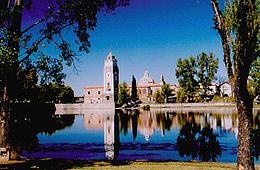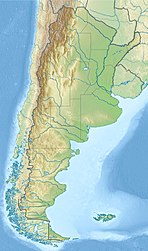Jesuit Block and Estancias of Córdoba
| UNESCO World Heritage Site | |
|---|---|
 View of the Estancia Alta Gracia | |
| Location | Córdoba Province, Argentina |
| Includes |
|
| Criteria | Cultural: (ii), (iv) |
| Reference | 995 |
| Inscription | 2000 (24th Session) |
| Area | 38.12 ha (94.2 acres) |
| Coordinates | 31°25′14″S 64°11′28″W / 31.42056°S 64.19111°W |
The Jesuit Block and Estancias of Córdoba (Spanish: Manzana Jesuítica y Estancias de Córdoba) are a former Jesuit reduction built by missionaries in the province of Córdoba, Argentina, named a World Heritage Site in 2000.[1]
The Manzana Jesuítica contains the University of Córdoba, one of the oldest in South America, the Monserrat Secondary School, a church, and residence buildings.[1] To maintain such a project, the Jesuits operated six Estancias (residences) around the province of Córdoba,[2] named Caroya, Jesús María, Santa Catalina, Alta Gracia, Candelaria, and San Ignacio.[3][4]
The farm and the complex, started in 1615, had to be left by the Jesuits, following the 1767 decree by King Charles III of Spain that expelled them from the continent.[5] They were then run by the Franciscans until 1853, when the Jesuits returned to The Americas. Nevertheless, the university and the high-school were nationalized a year later.
Each Estancia has its own church and set of buildings,[2] around which towns grew, such as Alta Gracia, the closest to the Block. The Jesuit Block and the Estancias can be visited by tourists; the Road of the Jesuit Estancias is approximately 250 kilometres (160 mi) in length.
Jorge Mario Bergoglio, who would later become Pope Francis, lived there.[6]
See also
[edit]References
[edit]- ^ a b "Jesuit Block and Estancias of Córdoba". UNESCO. Retrieved 20 August 2018.
- ^ a b "The Road of the Jesuit Estancias (Jesuit Ranches)". Archived from the original on 7 November 2001. Retrieved 20 August 2018.
- ^ The Estancia San Ignacio no longer exists, as it was reduced to rubble.
- ^ Córdoba Turismo. "Ruinas de San Ignacio". Archived from the original on 2017-08-09. Retrieved 2018-08-20.
- ^ Manfred Barthel. The Jesuits: History and Legend of the Society of Jesus. Translated and adapted from the German by Mark Howson. William Morrow & Co., 1984, pp. 223-4.
- ^ "Biografía de Jorge Bergoglio" (in Spanish). El Litoral. 14 March 2013. Archived from the original on 15 March 2013. Retrieved 14 March 2013.
External links
[edit]- Jesuit Block and Estancias of Córdoba - Argentine Tourism Office
- Estancias Jesuíticas (in Spanish)
- Images of the Estancias - Government of Córdoba (in Spanish)
- Jesuitic institutions in Argentina
- Buildings and structures completed in the 17th century
- World Heritage Sites in Argentina
- Buildings and structures in Córdoba Province, Argentina
- Jesuit history in South America
- Spanish missions in Argentina
- Former populated places in Argentina
- Tourist attractions in Córdoba Province, Argentina
- 1615 establishments in the Spanish Empire
- Córdoba Province, Argentina geography stubs

